Fashion in Art at Maidstone Museum

By Samantha Harris BA (Hons), MA. Collections Manager
April 2020
Maidstone Museum has a large costume collection of almost 10,000 items dating from the 1660s to the 2000s charting fashion through the ages. However, this is not our only source of fashion history! Other areas of the collections also highlight historical clothing and costume, such as the painting collections. Paintings not only provide a snapshot of fashion through time but also show the changing social and political values of the periods in which they were created. Portraits particularly provide essential information about the way in which clothes relate to society and the image that the sitter wished to have recorded for posterity. Join us in this blog as we discover fashion history through examples from the art collection.
16th Century
1580s Italy
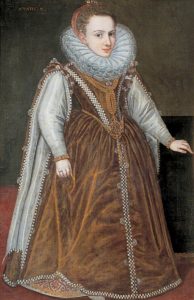
Portrait of Margherita Farnese, c. 1580
By Sofonisba Anguissola
Oil on Canvas
Accession: MNMEG 1959.1.100
Margherita Farnese was a member of the family of the Duke of Parma. In this painting she is but a child, probably no more than 13 years of age and in a couple of years she would be married to the future Duke of Mantua. Sadly, the marriage did not last more than 2 years and Margherita spent the rest of her life as a nun in Parma.
In this full length portrait, she is wearing a large cartwheel ruff, padded and slashed sleeves and decorated Spanish farthingale with underskirt. The height of fashion in the Italian court of the time. Until the mid-19th century there was little distinction between adult and children’s clothing, with children often wearing similar fashions to adults, particularly those of higher status such as royalty and nobility.
This painting is also unusual for its time as it was painted by a woman. The attributed to the artist, Sofonisba Anguissola, it is an important and rare example of a successful and famous female artist of the renaissance. Sadly, however well-known she was at the time, male artists have always been valued more highly and some of her paintings were misidentified as being by her male contemporaries.
17th Century
1650s – 1680s Holland
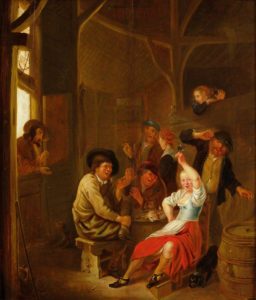
Peasants Carousing, 17th Century
By Dutch Ostade School
Oil on Panel
Accession: MNEMG 1897.66.51
This painting highlights the differences in fashion between higher and lower status peoples, as well as changes over time and across countries. This scene shows a woman encouraging the men in a tavern to have another drink. Paintings of ‘peasants’ making merry or brawling was a popular genre for artists working in and around Haarlem, Delft, The Hague and Leyden in the Netherlands. The woman here is wearing a light blue corset with a bright red skirt and apron which is hiked up above her knee. This is not the behaviour or clothes of a high status woman. The rest of the figures are painted in fairly muted tones making the woman stand out, with stereotypical wide brimmed hats and short trousers worn by the men. The viewer is encouraged to think of peasants as pleased and content with their lot. Pictures like this of well-fed, happy poor people were popular commissions and purchases among the more affluent classes in Britain during the 18th and 19th centuries.
1660s-1670s Britain
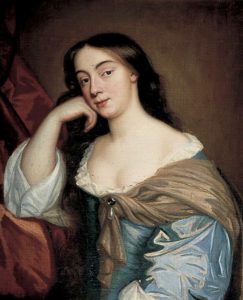
Barbara Villiers, Duchess of Cleveland (1640-1709)
After Peter Lely (1618-1680)
Oil on Canvas
Accession: TA134
Barbara Villiers was a mistress of Charles II and also known as the ‘Uncrowned Queen’ of Great Britain. Due to this she enjoyed a high status and could afford fashionable clothing. Here however, she is painted, unusually, wearing informal dress of the period. She wears a light blue silk dress with white cotton trim to the collar and cuffs. A sash of dark gold is draped over her left shoulder and pinned to the centre of her dress with a pearl, a demonstration of her wealth and favourable position.
1670s – 1700 Britain
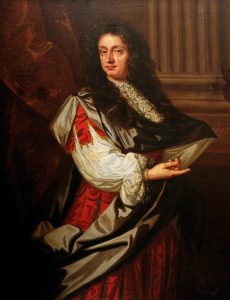
Rider family member of Boughton Place, Kent
By John Riley
Oil on Canvas
Accession: MNEMG 1938.22
This member of the local aristocracy is wearing a fashionable long black wig. Wigs for men first became fashionable at the French court of Louis XIV when he lost his hair. Charles II introduced the shorter periwig to England in 1660. The style of wig worn in this portrait was fashionable until around the 1690s, consisting of a mass of curls which frame the face and fell round the shoulders. He also wears a fashionable voluminous vest and tunic, with a grey silk sash. The lace white carvat was quite a recent invention, with collars having become obscured by wigs, they were replaced with the fall of linen or lace, often mounted on ribbon. The outfit contained a wonderfully opulent mixture of decorative layers.
18th Century
1760s – 1810s Britain
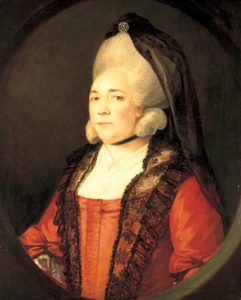
Mrs Burbridge of Staverton Hall, Northamptonshire
Attributed to Nathaniel Dance-Holland (1734-1811)
Oil on Canvas
Accession: TA168
Here we see a shift to extreme hairstyles and wigs for women, with Mrs Burbridge’s light grey wig in the traditional egg shape of the late 1700s. She is wearing a plain red dress with white kerchief, and white lace cuffs to the elbow length sleeves, a more modest look for an older lady. Draped over her head is a black veil, complementing the black lace shawl falling down her front, this possibly suggests she was in mourning. As this is a short, half portrait, we can only assume, but it is likely that she may be wearing a sack back gown, which was popular during this period.
1770s – 1800 Britain
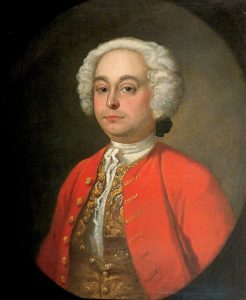
Thomas Best of Boxley (1759-1815)
Attributed to Gilbert Stuart (1754-1828)
Oil on Canvas
Accession: MNEMG 1955.87
This member of a local family is dressed in the fitted, collarless, scarlet coat of an elegant gentleman and an elaborate gold waistcoat. Beneath this we can see a white shirt and high neckerchief. He is also wearing a short white wig with a small ponytail tied with a black ribbon at the back. The move to fitted / tailored fashion for men, away from the opulent and voluminous look of the century before is notable (compare this with the costume of the Rider family member above).
1780s – 1800 Britain
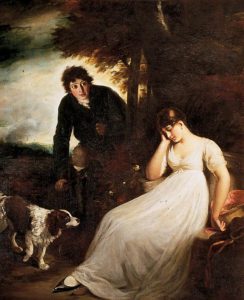
Opie, John; The Surprise; Maidstone Museum & Bentlif Art Gallery; http://www.artuk.org/artworks/the-surprise-76743
Both figures in this period artwork wear regency period fashion, reminiscent of Jane Austin era characters’ classical silhouettes. The female character wears a romantic style, elegant muslin gown, with a high waistline, just under the bust, known as ‘empire line’. While the male figure wears short trousers and long boots, a fitted jacket and neckerchief. This painting shows overuse of bitumen pigment, a tarry paint which gave an instant golden brown glow to popular 19th century history paintings such as this.
19th Century
1830s Britain
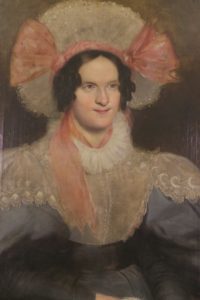
Depicted in evening dress during a period when the ‘double pyramid’ shape was fashionable, Mrs Wakefield is clearly a woman with an eye for the latest extravagant fashions. She wears a huge brimmed, starched tulle cap of the type worn with dinner dress, trimmed lavishly with rose-coloured ribbons. Her dress is a grey-blue satin with a very wide shoulder line and balloon sleeves, covered by a pelerine of fine, decorated lawn. A small ruff, fashionable until 1836, adds to the opulence of the outfit. Her waist is tightly laced and emphasised by a wide belt. Her dark, glossy hair is arranged in a popular style of the period for the evening: centrally parted with smooth hair to the temples and ringlets dangling over the ears.
1830s Britain
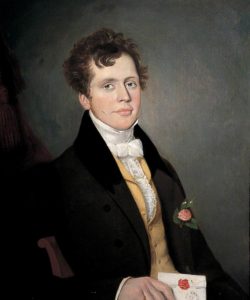
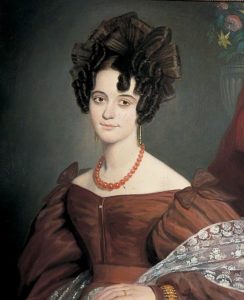
Edward and Sarah Walker (of Canterbury) Engagement portraits
By JB Haslehurst
Oil on canvas
Accession: TA141 & TA142
We have a number of couple or engagement portraits in the collection. You can see clearly that these are intended as a complimentary pair of portraits, with the compositions having sitters facing towards each other.
These portraits are of Sarah and Edward Walker of Canterbury, painted around 1830 – their costume helps date the pieces as her dress has taken a clear step away from the regency period gowns of the early 1800s but is not yet as demure as the mid and late Victorian period costume. Sarah’s costume is similar to that of Mrs Wakefield (shown previously), a plain burgundy gown with wide shoulders and silk sleeves, as well as the fashionable hairstyle of the time. Though as a younger sitter, she has a slightly more youthful style, with bare shoulders and a lace shawl. While Edward wears a black, wide collared jacket, a yellow waistcoat, and a white bowtie style cravat with high collar
Interestingly, there is much symbolism within the artwork. The roses are mirrored in each of the pieces symbolising love, youth and fertility. You see her engagement ring and he holds a letter in his hand which may be a symbol of his intentions and commitment.
1860s Britain
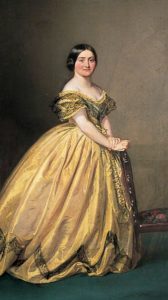
Mrs Wakefield of Maidstone, C. 1833-1834
Artist unknown
Oil on Canvas
Accession: TA156
This style of dress is arguably what most people think of when the term ‘Victorian’ costume is used. Though the portrait was painted in the 1860s – this was the prevalent fashion for women from the 1840s – 1860, with the iconic ‘Bell Tent’ shape. The drooping silhouette with wide shoulders and low set sleeves draw attention to the shoulder. Her hair is fashionably parted in the centre and the front section is sleeked down to be looped over the ears. An alternative hairstyle of the time was for the hair to be draped in ringlets and wound into a knot or chignon. Evening dresses of this era were somewhat restrained, often made from plain but luxurious fabrics, relying for effect instead on the contrast between the plain silks and liberal trimmings of lace, and often artificial flowers. As we see there is stark contrast here between the yellow silk and black lace.
Fashion trends often stemmed from the clothing worn by ‘celebrities’ of the day, and at this time, Queen Victoria herself was a figure who many women wished to emulate. As such, trends changed through the years, to some extent based on the clothes worn by the aging monarch. While she was young, Victoria wore fashions such as this shown by Mrs Dowson, but as she became older, more reserved fashions with higher necklines and long sleeves, more suitable to her age, were worn by the Queen, and public. The fashionable silhouettes continued to change shape through the decades of Victoria’s reign, achieved through the highly restrictive shape changing undergarments such as corsets, bustles, crinolines and cages.
1860s Britain
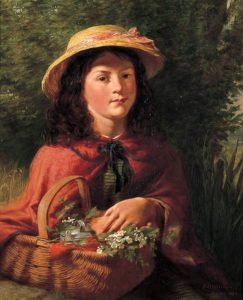
Girl with a lunch basket, 1860
By Robert Collinson (1832-1890)
Oil on Canvas
Accession: MNEMG 31
The young girl is shown in informal, rural clothing, wearing a red wool cloak and straw hat. This differs greatly from the urban fashion of this time, such as the ‘Bell Tent’ shape (as worn by Mrs Dowson above) favoured for urban women. This shows again a disparity in the clothing worn by people of different status.
Painted in London when the artist was 28, it is a ‘portrait’ of a country girl in her natural setting, designed to appeal to the city–dwelling, middle-class patron (similar to the Dutch ‘peasant’ or village paintings of around 200 years earlier!). The girl is wearing a red wool cloak, the standard colour for rural wear, flattering country complexions and brightening dull days. By the 1830s, it was more likely to be an old woman’s garment than a young girl’s. It survived as party wear for children until the early 20th Century. Our girl also wears a plaited straw hat, probably made in Dunstable of Luton, and typical country wear.
1870s Britain
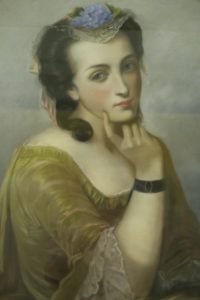
Lady in ‘Watteau’ Dress c. 1870
Artist unknown
Pastel
Accession: MNEMG
France, the fashion leader of Europe, had recently endured a horrific siege of Paris during the Franco-Prussian War. English fashions had taken over temporarily and everyone, regardless of class, dressed alike. By 1871, Paris recovered, and the upper classes resumed balls and salons, popularising a taste for furnishings and dress styles reviving the Louis Seize period of the 1770s. Women wore their hair high and elaborate, with a hat perched on the front and tilted forward. Overskirts, looped up into 18th century style ‘panniers’, joined the bustle in a remake of the Watteau shepherdess (Victorian style). Women’s dress was excessively complex with multiple layers of frills, ruffles, lace, ribbons and puffs. Further 18th century references included a revival of floral chintz and quilted underskirts. This oval pastel drawing is of a very Victorian woman, wearing a ‘copy’ or revival of an 18th century sack-back dress in gold silk.
1870s Britain
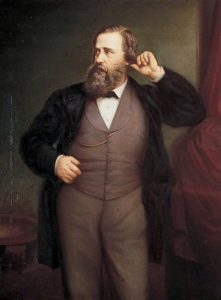
Julius Lucius Brenchley Esq (17th October 1876)
By WC Dobson (1817-1898)
Oil on Canvas
Accession: MNEMG 1876.95
This portrait of Maidstone collector and museum donor, Julius Brenchley sees him in the formal attire of the 1870s. He wears a collared white shirt with an early version of a bow tie and grey 2 piece suit with a black frock coat. The frock coat was a hallmark of Victorian respectability which was worn by the upper, middle and professional classes (to which Brenchley belonged) and was often worn with a top hat. In the portrait we also see the chain for Brenchley’s pocket watch, attached to his waistcoat, a must have for any gentleman of the time.
1880s Britain
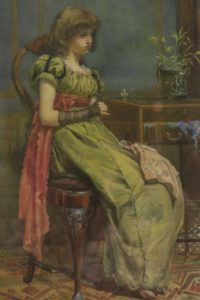
The Sampler, 1884
By James Crompton (1853-1916)
Watercolour
Accession: MNEMG 1958.5
This young girl is wearing a version of Aesthetic dress, inspired by a combination of Medieval and Renaissance heroines. Aesthetic dress was worn by artistic women revolting against the tightly corseted ‘skittles’ or ‘wooden skittle’ silhouette of contemporary fashion. It is high waisted and similar to the dresses of the 1820s, even in colour – a greenish yellow. Her hair is thick, waved and brushed over her eyes in the manner of a Burne-Jones lady. This was a fashion straight from popular, contemporary Victorian painting, and its main purpose was to show off the beautiful and expensive silks that discerning women of artistic taste would choose.
1890s, Britain
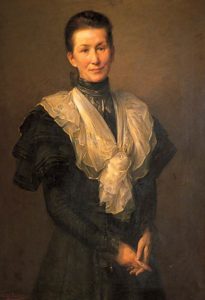
Miss FJ Dolby, 1896
By Augusto Stoppoloni
Oil on canvas
Accession: TA123
Miss Dolby, whose portrait was commissioned by her patients and Friends of Railwaymen, was a wealthy benefactress who donated land to build the Railway Mission Convalescent Home. She became its first Honorary Superintendent from 1892 to 1904. Her dress style expresses the prevailing 1890s standard of feminine ‘good taste’ and middle class restraint. It is also a portrait of a quietly resolute woman. Miss Dolby wears a black formal dress in fine wool, with fashionably large cape sleeves and tight arms with pointed cuffs. This reflected the ‘pseudo-medieval’ style, currently undergoing a fashion revival. She also wears a white fill-in dress front with a high ‘choker’ collar. A frilly, white muslin fichu, knotted over her chest adds a little informality.
20th Century
1920s – 1970s Britain
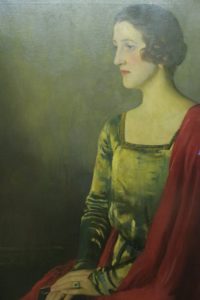
Doreen Lady Brabourne C.I., 1922
By Oswald Birley (1880-1952)
Oil on Canvas
Accession: MNEMG
Doreen Knatchbull, Lady Brabourne (1896-1979), was wife of 5th Baron Brabourne and daughter of 6th Marquess of Sligo. She had links to the royal family, Lord Mountbatten (Prince Philip’s uncle) was the father of her younger son’s wife. Her status enabled her to have a private dress maker and afford the latest couture fashions. Her entire wardrobe, numbering over 3,000 pieces, was donated to the museum when she died in the boat explosion which also killed Lord Mountbatten on 27th August 1979. The collection, as well as this portrait, provide a fascinating snapshot of how a woman wished to present herself in private, and to society, through her life.
The artist, Birley was a great friend of the Brabourne family and often stayed at Mersham-le-Hatch (the Knatchbull estate). This low key portrait of Doreen Lady Brabourne, aged 26, is almost meditative. Doreen’s classically elegant beauty and natural affinity with her chosen outfit (a simple green velvet evening dress and red shawl) is unpretentious and understated. During the 1920s-30s, most dresses were cut ‘on the cross’ in tapered panels, which resulted in a slim, clingy, long-legged look. This style suited Doreen naturally, as she was tall, slim and elegant.
In conclusion to this blog, as the photographer Cecil Beaton commented, ‘Fashions are ephemeral but fashion is enduring’ (Cecil Beaton, The Glass of Fashion, 1954, pp 1-3). Historically fashion was a symbol of the power of the monarchy, aristocracy and upper classes, dictated by their lifestyle and moulded by their tastes. A clear and visible boundary and barrier between the classes, as we can see in the early artworks from the collection.
Beaton also noted that ‘changes in fashion correspond with the subtle and often hidden network of forces that operate on society – political, economic and psychological factors all play their part. In this sense fashion is a symbol’. So when you next see the costume of a sitter in an artwork, why not consider the hidden messages that can be seen, through how the people are represented by what they wear, and the wider context in which it was created. For an overview of Maidstone Museum’s Costume Collection please look here: https://museum.maidstone.gov.uk/explore/collections/costumes/ , and online access to the Museum’s oil painting collection please visit: https://artuk.org/visit/venues/maidstone-museum-bentlif-art-gallery-3357 .
References
Ashelford, Jane. The Art of Dress: Clothes Through History 1500-1914. National trust, 1996.
Rothstein, Natalie (ed). 400 Years of Fashion. V&A Publishing, 2010.
The Public Catalogue Foundation. Oil Paintings in Public Ownership: Kent. Public Catalogue Foundation, 2004.
